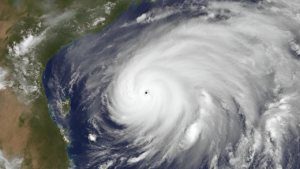Physical Address
23,24,25 & 26, 2nd Floor, Software Technology Park India, Opp: Garware Stadium,MIDC, Chikalthana, Aurangabad, Maharashtra – 431001 India
Physical Address
23,24,25 & 26, 2nd Floor, Software Technology Park India, Opp: Garware Stadium,MIDC, Chikalthana, Aurangabad, Maharashtra – 431001 India

With inputs from Vivek Saini
Chennai heaved a sigh of relief as the India Meteorological Department reported that Cyclonic Storm Michaung has weakened, with the Director General, Dr. Mrityunjay Mohapatra, noting the start of the weakening process after the storm’s Tuesday landfall. The streets of Chennai, a southern city in India, witnessed surging waters reaching chest-high on Tuesday last, claiming the lives of eight individuals amidst severe flooding. The town had already faced the brunt of intense showers and strong winds on Monday, causing widespread destruction as Cyclone Michaung approached.
Mahesh Palawat, a weather expert and meteorologist at Skymet Weather Services, confirmed that the recent rainfall was not a typical occurrence. He mentioned that December is a month when cyclonic storms usually move towards Tamil Nadu and Andhra Pradesh, and the formation of the storm itself is not indicative of any abnormality. He explained that the increased intensity of the rains linked to the cyclone is a result of climate change.
Roxy Mathew Koll, a Climate Scientist at the Indian Institute of Tropical Meteorology, explained that El Niños typically reach their peak around Christmas in December, a characteristic reflected in their name derived from the Spanish term for ‘little boy.’ She mentioned, “As oceans absorb more than 93 per cent of the additional heat from global warming, El Niño is also becoming stronger.” Koll emphasized that these phenomena are no longer “little boys” but have evolved into formidable forces of the sea. Koll pointed out that changes in ocean-cyclone interactions have surfaced in recent decades due to Indian Ocean warming and should be closely monitored, especially with improved observations. The scientist highlighted that future climate projections indicate a continued rapid warming of the Indian Ocean, accompanied by an increase in the intensity of cyclones in this basin.
Nature’s Fury Unleashed
Chennai faced the onslaught of intense showers and strong winds as Cyclone Michaung approached, resulting in widespread havoc. Almost every neighborhood in the city was submerged, leading to the suspension of flight operations, stranding hundreds of individuals, causing infrastructure damage, and tragically claiming the lives of at least five people. The deluge transformed roads into rivers, prompting state and central disaster response teams to initiate rescue operations using boats and rafts. The torrents swept away vehicles and uprooted numerous trees along the coastal city. Additionally, the powerful gusts snapped power lines, leaving Chennai without electricity for most of Monday.
In less than 24 hours, the capital of Tamil Nadu experienced an extraordinary rainfall of 415mm, recorded between 8.30 pm on Sunday and 1.30 pm on Monday, as reported by the India Meteorological Department (IMD). Weather experts noted that this downpour was the most significant in Chennai since the devastating floods of December 2015, which claimed the lives of 250 people.
Despite the staggering rainfall, Chennai grappled with the relentless rain, leading to widespread flooding and households being plunged into darkness. Adding to the challenges, the city faced another heavy rain on Monday. Experts anticipated that while the showers might not wholly cease, there would be a reduction once Cyclone Michaung moved a considerable distance from the city.
City Submerged, Lives Disrupted
The incessant rains inundated nearly every part of Chennai, with the worst-hit areas being the low-lying neighborhoods in southern Chennai, including Perungudi, Velachery, and Guduvanchery. Social media videos depicted dozens of cars being washed down driveways and colony lanes, compelling residents to park their vehicles on flyovers.
In response to the crisis, rescue officials were deployed across Chennai, according to government spokespersons. Over 2,000 people were relocated to government relief camps, as stated by a Tamil Nadu government official. Prime Minister Narendra Modi assured assistance to the Tamil Nadu government, expressing the Centre’s commitment to dealing with the heavy rains. Union Home Minister Amit Shah engaged with Chief Minister MK Stalin to coordinate relief efforts in the face of the challenging situation.
From Rescue Operations to Lingering Concerns
In a post on X, Chief Minister Stalin urged all political parties and volunteers to collaborate with the government in overcoming the calamity caused by CycloneMichuang, characterized by unprecedented rains. He revealed the appointment of 13 ministers dedicated to accelerating relief efforts, with additional personnel actively engaged in fieldwork.
Chennai airport faced closure on Monday due to rainwater submerging the runway and stranding multiple aircraft. The Chennai airport operator, in a post on X, announced the cancellation of all flights to and from the busy airport until 9 am on Tuesday. Simultaneously, officials from the Southern Railways reported the cancellation of several trains scheduled to reach or travel through Chennai.
As the river Adyar overflowed, officials cautioned residents about the potential presence of crocodiles in the waters, urging them to avoid provoking these creatures. The Additional Chief Secretary (Environment, Climate Change, and Forests) of the Tamil Nadu government, Supriya Sahu, clarified in a post on X that crocodiles are harmless if left undisturbed.
Despite reassurances, experts noted that the swelling Adyar exacerbated the floods. Environment activist Nityanand explained that high tides hindered water drainage to the sea through rivers, emphasizing that widespread flooding was inevitable unless the rain subsided.
Residents from various neighborhoods navigated through waist-deep water to reach any operational grocery stores in a quest for essential food and supplies. Simultaneously, numerous individuals resorted to desperate pleas on social media platforms, highlighting the urgent need for assistance and support in the challenging conditions caused by the catastrophic situation.
References: